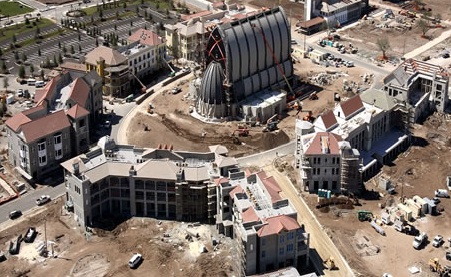Across the U.S., dozens of colleges and universities are planning or building major campus expansions. However, unlike the 1990s which saw gleaming bioscience research facilities appear on campuses, the new construction is calculated to help attract and retain faculty and students with amenities for living and shopping. Almost without exception, these projects are in a strictly neotraditional design mold.
Across the U.S., dozens of colleges and universities are planning or building major campus expansions. However, unlike the 1990s which saw gleaming bioscience research facilities appear on campuses, the new construction is calculated to help attract and retain faculty and students with amenities for living and shopping. Almost without exception, these projects are in a strictly neotraditional design mold.
After decades of institutional architecture built for efficiency, schools without distinctive college towns or well cultivated campuses are finding themselves at a competitive disadvantage with universities with well cultivated campuses or college towns. Meanwhile, urban campuses are looking for ways to capitalize on their property, while providing amenities for the campus and local community. Here's a sampling of the many projects underway.
- In Connecticut, University of Connecticut is planning to level their town's downtown for a $165 million mixed-use project with 800 residential units and hundreds of thousands of square feet of office and retail space.
- In Philadelphia, the University of Pennsylvania is planning a major expansion across the Schuylkill River, hoping to expand their facilities and bolster the community.
- At the University of California at Davis, officials hope to break ground soon on the West Village project, which will eventually house over 4,300 people on what is now 224 acres of vacant university-owned land.
- Ohio State University has been working for years to revitalize High Street in Columbus, Ohio.
- Even tiny Hendrix College in Conway, Arkansas is constructing a 30 acre residential and commercial project called the Village at Hendrix, a project originally inspired by none other than Andres Duany himself.
Perhaps the most ambitious -- and controversial -- of these projects is the pet project of conservative Catholic and Domino's Pizza founder Tom Monaghan: Ave Maria, Florida. Through a similar legal arrangement used by Walt Disney to develop Disney World, Moghnahan and his partner Barron Collier Companies are developing a campus and college town of 30,000 for the Catholic university he helped found, Ave Maria University. As the campus takes shape, university officials hope it will be ready for fall 2007 classes.

While so many projects are moving ahead rapidly, I can't help but wonder whether they will actually result in the sense of place of legendary college towns developed over decades. It seems unlikely these massive projects will support the diversity of retail and housing choice that is the hallmark of these memorable places.
Here at the University of Maryland where I am a student, administration officials are deep in negotiations with an as-yet unannounced development partner for the East Campus Project, where officials hope to transform a 38-acre parcel of land containing vacant greenhouses, aging dormitories, and bus parking into a dense, mixed-use project where faculty and students can "live, work, and play." A community group I co-founded is working hard to ensure the resulting project reflects the unique character of our community -- and is closely integrated to both campus and the surrounding neighborhoods.

Planetizen Federal Action Tracker
A weekly monitor of how Trump’s orders and actions are impacting planners and planning in America.

Chicago’s Ghost Rails
Just beneath the surface of the modern city lie the remnants of its expansive early 20th-century streetcar system.

Amtrak Cutting Jobs, Funding to High-Speed Rail
The agency plans to cut 10 percent of its workforce and has confirmed it will not fund new high-speed rail projects.

Ohio Forces Data Centers to Prepay for Power
Utilities are calling on states to hold data center operators responsible for new energy demands to prevent leaving consumers on the hook for their bills.

MARTA CEO Steps Down Amid Citizenship Concerns
MARTA’s board announced Thursday that its chief, who is from Canada, is resigning due to questions about his immigration status.

Silicon Valley ‘Bike Superhighway’ Awarded $14M State Grant
A Caltrans grant brings the 10-mile Central Bikeway project connecting Santa Clara and East San Jose closer to fruition.
Urban Design for Planners 1: Software Tools
This six-course series explores essential urban design concepts using open source software and equips planners with the tools they need to participate fully in the urban design process.
Planning for Universal Design
Learn the tools for implementing Universal Design in planning regulations.
Caltrans
City of Fort Worth
Mpact (founded as Rail~Volution)
City of Camden Redevelopment Agency
City of Astoria
City of Portland
City of Laramie





























